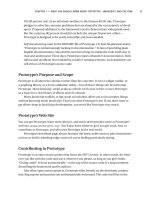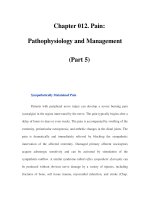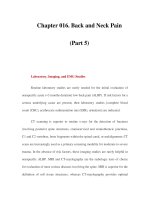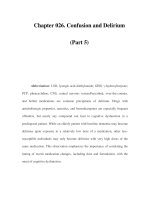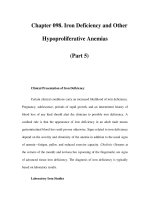Chapter 122. Acute Infectious Diarrheal Diseases and Bacterial Food Poisoning (Part 5) pps
Bạn đang xem bản rút gọn của tài liệu. Xem và tải ngay bản đầy đủ của tài liệu tại đây (40.88 KB, 5 trang )
Chapter 122. Acute Infectious Diarrheal Diseases
and Bacterial Food Poisoning
(Part 5)
History
The answers to questions with high discriminating value can quickly
narrow the range of potential causes of diarrhea and help determine whether
treatment is needed. Important elements of the narrative history are detailed in Fig.
122-1.
Physical Examination
The examination of patients for signs of dehydration provides essential
information about the severity of the diarrheal illness and the need for rapid
therapy. Mild dehydration is indicated by thirst, dry mouth, decreased axillary
sweat, decreased urine output, and slight weight loss. Signs of moderate
dehydration include an orthostatic fall in blood pressure, skin tenting, and sunken
eyes (or, in infants, a sunken fontanelle). Signs of severe dehydration range from
hypotension and tachycardia to confusion and frank shock.
Diagnostic Approach
After the severity of illness is assessed, the clinician must distinguish
between inflammatory and noninflammatory disease. Using the history and
epidemiologic features of the case as guides, the clinician can then rapidly
evaluate the need for further efforts to define a specific etiology and for
therapeutic intervention. Examination of a stool sample may supplement the
narrative history. Grossly bloody or mucoid stool suggests an inflammatory
process. A test for fecal leukocytes (preparation of a thin smear of stool on a glass
slide, addition of a drop of methylene blue, and examination of the wet mount) can
suggest inflammatory disease in patients with diarrhea, although the predictive
value of this test is still debated. A test for fecal lactoferrin, which is a marker of
fecal leukocytes, is more sensitive and is available in latex agglutination and
enzyme-linked immunosorbent assay formats. Causes of acute infectious diarrhea,
categorized as inflammatory and noninflammatory, are listed in Table 122-1.
Post-Diarrhea Complications
Chronic complications may follow the resolution of an acute diarrheal
episode. The clinician should inquire about prior diarrheal illness if the conditions
listed in Table 122-2 are observed.
Table 122-2 Post-
Diarrhea Complications of Acute Infectious
Diarrheal Illness
Complication Comments
Chronic diarrhea
Lactase deficiency
Occurs in ~1% of travelers with
acute diarrhea
Small-
bowel bacterial
overgrowth
Malabsorption syndromes
(tropical and celiac sprue)
Protozoa account for ~⅓ of cases
Initial presentation or
exacerbation of inflammatory bowel
disease
May be precipitated by traveler's
diarrhea
Irritable bowel syndrome
Occurs in ~10% of travelers with
traveler's diarrhea
Reiter's syndrome (reactive
arthritis)
Particularly likely after infection
with invasive organisms (Shigella
,
Salmonella, Campylobacter)
Hemolytic-
uremic syndrome
(hemolytic anemia,
thrombocytopenia, and renal failure)
Follows infection with Shiga toxin–
producing bacteria (Shigella dysenteriae
type 1 and enterohemorrhagic
Escherichia
coli)
Epidemiology
Travel History
Of the several million people who travel from temperate industrialized
countries to tropical regions of Asia, Africa, and Central and South America each
year, 20–50% experience a sudden onset of abdominal cramps, anorexia, and
watery diarrhea; thus traveler's diarrhea is the most common travel-related illness
(Chap. 117). The time of onset is usually 3 days to 2 weeks after the traveler's
arrival in a tropical area; most cases begin within the first 3–5 days. The illness is
generally self-limited, lasting 1–5 days. The high rate of diarrhea among travelers
to underdeveloped areas is related to the ingestion of contaminated food or water.
The organisms that cause traveler's diarrhea vary considerably with location
(Table 122-3). In all areas, enterotoxigenic and enteroaggregative E. coli are the
most common isolates from persons with the classic secretory traveler's diarrhea
syndrome.


